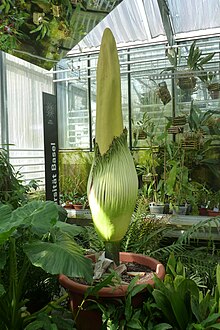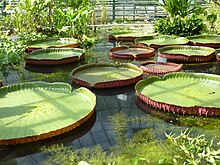Botanical Garden of the University of Basel
The Botanical Garden of the University of Basel is a public botanical garden in Basel . It belongs to the Botanical Institute of the University of Basel , to which it is adjacent. It is open all year round and consists of an outdoor area with various plantings ( dry border , wood , alpine , fern canyon , Mediterranean garden , showcases, systematic section according to Cronquist ) and four greenhouses (tropical house, Victoria house, succulent house , cold house).
history
The Botanical Garden of the University of Basel was laid out in 1589 in the lower college of the university on the Rheinsprung . It is the oldest botanical garden in Switzerland and, in turn, is linked to even older, private gardens that belonged to Basel pharmacists or doctors and that supplied material for study purposes and for the production of medicinal products. The monasteries, which were closed after the Reformation (1529), had their own gardens , and herbaria as well as herbal manuscripts and pamphlets made in Basel bear witness to a long tradition of occupation with botany.
The establishment of the university garden was connected with the establishment of a combined professorship for anatomy and botany until 1822 as part of the medical courses. The division was seasonal. The summer was suitable for teaching medicinal plants, the winter for the dissection of corpses, since they then decompose less quickly. The first professor to take up this chair was Caspar Bauhin , one of the "fathers of botany", and Basel botany gained quite a reputation. In retrospect, the university stated in the 18th century that the study of botany in Basel had been "always very interesting and perhaps more pursued than at any other university".
In 1692 the so-called “ hortus medicus ” or “doctor's garden” was relocated to the former cloister garden near the Predigerkirche , but without adequate facilities and funding. Sometimes the chair had to inject money from its own pocket, and sometimes the doctoral fees had to serve. The gardener only occasionally received a "gratiale" (grant) and instead of medicinal herbs planted useful plants for his own livelihood. In 1765 the medical faculty complained that the garden "had gotten into a very miserable and poor condition". After Werner de Lachenal (1736–1800) took over the professorship in anatomy and botany in 1776 and thanks to his lobbying, a suitable infrastructure was established by the end of the 18th century, and botanical studies began again. Lachenal achieved the construction of his own professor's apartment in the botanical garden, the financial improvement of the gardener and a regular annual contribution to the maintenance of the now public garden.
It was possible to bring the garden through the difficult time of the Helvetic Republic, which was difficult for the university , but it seems to have begun to slowly deteriorate again; At least the garden no longer met the increased demands on the display of rare and exotic plants and once again served the gardener as a source of income, as several professors stated in 1854. At that time the garden stood in front of the Aeschentor , where it had been relocated in 1836 due to the expansion of the Markgräflerhof to the municipal hospital. The garden has only had a permanent financial basis since 1862.
Due to the construction of the Botanical Institute in 1896, the garden changed its location again and was rebuilt in 1897 directly adjacent to the institute. In 1921 and 1966–1967 extensive changes took place. The Victoria House, which was built in 1898 especially for the giant water lily Victoria regia , is of architectural interest. Its centrally symmetrical construction type with dome goes back to the greenhouses of Joseph Paxton , which the latter had designed especially for the Victoria regia. As a historically valuable iron and glass building, it was renovated true to the original in 1996.
location
Botanical Garden and Institute are located within sight of the Spalentor , on the former site of the Spalengottesackers . This was in operation from 1824 to 1868 and was then closed due to the opening of the Gottesacker Kannenfeld , today's Kannenfeld Park .

In the immediate vicinity are the Basel University Library of the same age , the Vesalianum (Physiological Institute, 1883) and the Bernoullianum (Institute for Physics, Chemistry and Astronomy, 1874). Together they formed a university complex at the end of the 19th century, which was completed in 1939 by the university's new college building .
To the east of the botanical garden is a park, St. Peter's Square .
literature
- Edgar Bonjour : The University of Basel 1460-1960 . Helbing & Lichtenhahn, Basel 1960, p. 331-332; 466-467 .
- Marilise Rieder, Hans Peter Rieder, Rudolf Suter : Basilea Botanica . From saffron to the tree of gods. Birkhäuser , Basel 1979, ISBN 3-7643-1096-0 , p. 188-201 .
- Ulrike Jehle-Schulte Strathaus: Architectural Guide Basel . The building history of the city and its surroundings. Ed .: Dorothee Huber. AM , Basel 1993, ISBN 3-905065-22-3 , p. 206 .

